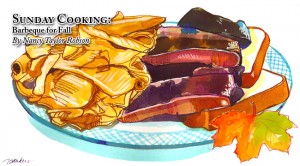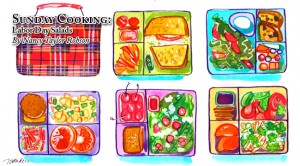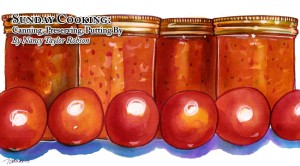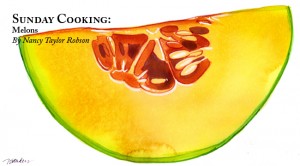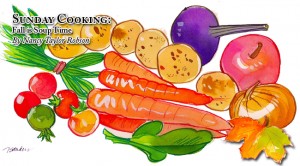 If you already know why you should know how to make soup stock, you can skip this first paragraph and go on to the soup rhapsodizing beneath it.
If you already know why you should know how to make soup stock, you can skip this first paragraph and go on to the soup rhapsodizing beneath it.
OK, now that I’ve culled the cognoscenti, let me make a quick case for one of the best ways to save money, make good use of every last bit of food you’ve paid for, and make great soup. AND make the house smell like you imagined your grandmother’s home should have smelled and didn’t. Stock. Yes, you can buy it in boxes these days, but buying it should be a choice based on time and energy constraints, not because you don’t know how to make your own. Soup stock in the freezer is like money in the bank. Chicken, meat – what remains of a ham bone, beef roast or shank, lamb shoulder, chicken or turkey or duck carcass, whatever — fish, and vegetable stock all make use of the last stalk of celery, a single carrot, half an onion, a few seasonings, and water. Leftovers that might be thrown out (or composted, which could bring me to another mini-rant, but won’t). Freeze stock in pint containers (be sure to label them) and you can come home, pull out one or two, put it into a pot set on low to defrost while you pull a few things out of the frig to add – a potato and some cheese, peppers and leftover rice, a can of beans and some garlic and parsley and a squeeze of lemon. In no time flat, you have a real meal that costs, depending on ingredients, as little as a buck or two for a couple of people. (We’re not including in either the ‘people’ category or the financial equation growing teenage boys, who are voracious and need food that upholsters their insides for more than an hour.). OK, think it over. There’s a link below that will give you something of a soup stock tutorial.
Now, for the soups. Soup not only makes terrific use of leftovers and stretches your dollar, but is virtuous too since it can help to edit the waistline as it fills you up without being heavily caloric. Additionally, it usually offers about half of your daily recommended veggie requirement in one go.
Fall (once we’re through our current Amazon Forest Period) is soup time. It’s the homey, turn-of-the-season, days-closing-in warmth we’ve been longing for in our imaginations since the dog days and those 100-degree temps. And right now there’s still a variety of fresh local ingredients available at the farmers’ market and coming out of unruly season’s-end gardens.
Mulligatawny with an apple and the last of the tomatoes, which never taste quite right after August. Oxtail, gumbo, boullabaisse, split pea, albondigas with pork and beef meatballs, stracciatella, an Italian egg drop soup that you can make in about 10 minutes and throw in some kale or spinach for greenery, harvest corn chowder with bacon, Scotch broth with barley, oyster stew with thyme and sautéed onions, clam chowder, salmon and potato chowder, duck and tortilla soup, green bean and bacon with orzo and herbs, minestrone, Thai shrimp and noodles, old-fashioned chicken noodle.
For the vegetarians: Roasted sweet potato soup with poblanos, peasant lentil vegetable, leek and potato, Ghanian peanut soup, vegetarian minestrone, Swiss cheese and onion, Hungarian mushroom (you can use tamari sauce to add the kind of umami flavor that a beef stock imparts), vegetable chowder, cauliflower with mushrooms and stilton, creamy roasted parsnip, carrot and turnip with aged Edam, Gumbo Z-Herbes, eggplant and mushroom with sautéed sweet pepper, Tuscan bean with tomatoes and kale, roasted tomato-and-onion – the fresh tomatoes may not taste like much this time of year, but roast them on a cookie sheet for about an hour at low heat along with an onion and you have something sweet and magical. It’s great pureed for pasta sauce, and is a lovely coulis with broiled salmon slathered in curried mustard.
For Rosh Hashanah, which begins today: artichoke potato, beef and barley, chicken with matzo balls, creamy sweet potato, Hungarian vegetable and more.
Sometimes, it’s just a help to meander through cookbooks or the internet with the ingredients you have on hand looking for new combinations to try.
Here are some options.
Mexican Squash Soup
2 tblsp butter or olive oil
1 small onion, chopped
¼ cup chopped celery
¼ cup sweet pepper, chopped
4 cups chicken or vegetable stock
1 dried red Mexican chili or 1 fresh Serrano or other hot pepper to taste, whole or omit.
1 ½ cups peeled, diced winter squash (acorn, hubbard, butternut, etc)
1 cup frozen or fresh corn
Melt butter or heat oil in saucepan. Sauté vegetables until soft, about 5 minutes. Add stock and bring to boil. Add squash and simmer until tender.
Roasted Sweet Potato and Poblano
2 sweet potatoes, peeled and cubed
1 tblsp smoked paprika
1 tblsp chili powder
1 tsp cumin
1 tsp salt
1 tsp pepper
2 tblsp olive oil
1 shallot minced
1 med poblano, chopped
1 tblsp olive oil
4 cups chicken stock or 4 cups water and a large chicken bullion cube
3 tblsp fresh cilantro
Toss cubed potatoes with spices and olive oil. Roast on a cookie sheet at 325 for about 3o minutes or until semi-tender. Sauté shallot (or onion) and pepper in olive oil until onion is translucent and some of the peppers have some browned edges. Put all into a soup pot with stock or water and bullion and simmer for about 15 minutes. Puree with a hand blender or cool a bit before putting it into the blender. To serve, top with chopped fresh cilantro.
Minestrone
½ lb meaty bacon
3 tblsp olive oil
2 carrots, chopped
1 turnip, chopped
2 onions, chopped
2 ribs celery, chopped
4 cloves garlic, minced
3 large tomatoes or 1 15-oz tin chopped tomatoes with juice
1 cup green beans, chopped
½ cup sweet pepper. diced
3 tblsp fresh oregano, minced
3 tblsp fresh parsley, minced
1 15-oz. can cannellini beans or 2 cups of dried beans that have been plumped and simmered until al dente
1 cup elbow macaroni
7-8 cups beef stock
salt and pepper to taste
Use a large heavy pot for this – enameled iron works well. Heat olive oil in pot while you slice bacon into inch-long pieces. Sauté in hot olive oil until crisp-ish. If there is too much fat in the pan, spoon some out. (You can also substitute ham if you don’t want bacon.). Meanwhile, cube/dice the carrots turnip, onions, celery and add to the hot fat/oil. Sauté for about 10 minutes until starting to brown slightly on edges. Add garlic and sauté for another minute. Then add tomatoes, sweet pepper, green beans, herbs and stock. If using plumped dried beans, add them now. Simmer for about 40 minutes. Add canned beans and macaroni. Cook, stirring to keep things from sticking on the bottom for about 15 minutes or until pasta is done. You may need to add liquid by this point; this soup is thick. Serve with crusty garlic bread and robust red wine.*
https://en.wikipedia.org/wiki/Stock_(food)
https://allrecipes.com/Recipe/mulligatawny-soup-i/detail.aspx
https://www.care2.com/greenliving/peasant-lentil-vegetable-soup.html
https://allrecipes.com/Recipe/african-peanut-soup/detail.aspx
https://www.thehungrywife.com/appetizers/vegetable-chowder-recipe/
https://www.marthastewart.com/318061/vegetable-chowder
https://glutenfreegoddess.blogspot.com/2008/10/roasted-vegetable-chowder.html
https://www.cook-book.com/recipes/harvest_corn_chowder_bacon.html
https://www.epicurious.com/recipes/food/views/Gumbo-Zherbes-with-Red-Beans-14272
https://www.epicurious.com/recipes/food/views/Duck-Tortilla-Soup-234250
Kosher soups:
https://kosherfood.about.com/od/koshersouprecipes/Kosher_Soup_Recipes.htm
https://www.kosherdelight.com/Soups.shtml
*This is my last Sunday Cooking column for the ChestertownSpy and TalbotSpy. But I’m sure it won’t be the last word from either Spies about food. Thanks to you all.



